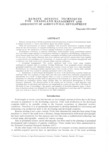Remote Sensing Techniques for Grassland Management and Assessment of Agricultural Development
Tropical agriculture research series : proceedings of a symposium on tropical agriculture researches
| ISSN | 03889386 |
|---|---|
| 書誌レコードID(総合目録DB) | AA00870529 |

本文フルテキスト
tars18-_241-262.pdf3.42 MB
Remote sensing deals with the acquisition and interpretation of spectral measurements made at distant locations to obtain information about the earth's surface.
With the development of sensors combined with powerful information systems brought about by the advancement of computer technology in recent years, new opportunities have been opened up for the application of remote sensing techniques in agriculture.
Experiments consisting of spectral reflectance measurements using gound-based sensors have provided a large amount of information relating to vegetation identification, estimation of plant biomass and crop yield, crop condition assessment including water and fertilizer deficiency. On the basis of the results obtained, data from airborne and satellite sensors have been applied to agricultural use including crop forecasting, or resources and environment management and evaluation over wide areas with computer-aided analysis techniques.
1 Grassland management: The author analyzed land cover types using Landsat multispectral scanner data in northern Tochigi Prefecture. Four grassland classes reflecting grassland conditions were identified among the fourteen classes of land cover types described. Furthermore, by combining Landsat spectral data with records of first cutting yield, multiple regression model was created to estimate grassland yield of the district.
2 Assessment of agricultural deveIopment: In most of the developing countries which are endowed with vast expanses of land, there.are still areas which have remained comparatively unexplored. As a result, in these regions, there is a lack of precise soil surveys which are most important for selecting suitable land for agricultural development in a short time. The author developed an evaluation system using Landsat data for agricultural development in North Sumatra, Indonesia. The characteristics of the system are as follows: 1) each thematic map including data on elevation and land-use was integrated as a grid cell data file of 500 meter by 500 meter in size, 2) according to the quality and quantity of available thematic maps, a threestep evaluation system was designed for carrying out evaluations at each step, and 3) vegetation type was used as a source of information for land evaluation.
With the development of sensors combined with powerful information systems brought about by the advancement of computer technology in recent years, new opportunities have been opened up for the application of remote sensing techniques in agriculture.
Experiments consisting of spectral reflectance measurements using gound-based sensors have provided a large amount of information relating to vegetation identification, estimation of plant biomass and crop yield, crop condition assessment including water and fertilizer deficiency. On the basis of the results obtained, data from airborne and satellite sensors have been applied to agricultural use including crop forecasting, or resources and environment management and evaluation over wide areas with computer-aided analysis techniques.
1 Grassland management: The author analyzed land cover types using Landsat multispectral scanner data in northern Tochigi Prefecture. Four grassland classes reflecting grassland conditions were identified among the fourteen classes of land cover types described. Furthermore, by combining Landsat spectral data with records of first cutting yield, multiple regression model was created to estimate grassland yield of the district.
2 Assessment of agricultural deveIopment: In most of the developing countries which are endowed with vast expanses of land, there.are still areas which have remained comparatively unexplored. As a result, in these regions, there is a lack of precise soil surveys which are most important for selecting suitable land for agricultural development in a short time. The author developed an evaluation system using Landsat data for agricultural development in North Sumatra, Indonesia. The characteristics of the system are as follows: 1) each thematic map including data on elevation and land-use was integrated as a grid cell data file of 500 meter by 500 meter in size, 2) according to the quality and quantity of available thematic maps, a threestep evaluation system was designed for carrying out evaluations at each step, and 3) vegetation type was used as a source of information for land evaluation.
| 刊行年月日 | |
|---|---|
| 作成者 | Tsuyoshi Akiyama |
| 公開者 | Japan International Research Center for Agricultural Sciences |
| 巻 | 18 |
| 開始ページ | 241 |
| 終了ページ | 262 |
| 言語 | eng |
